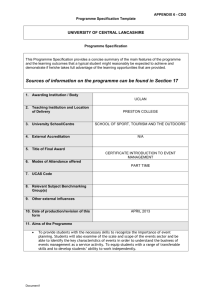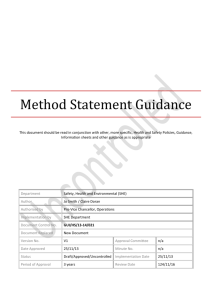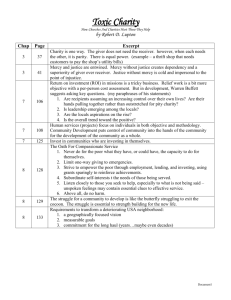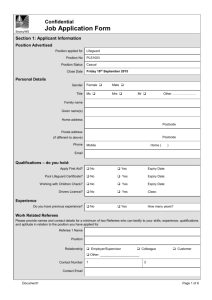Assessment Plan for: - University of Alaska Anchorage
advertisement
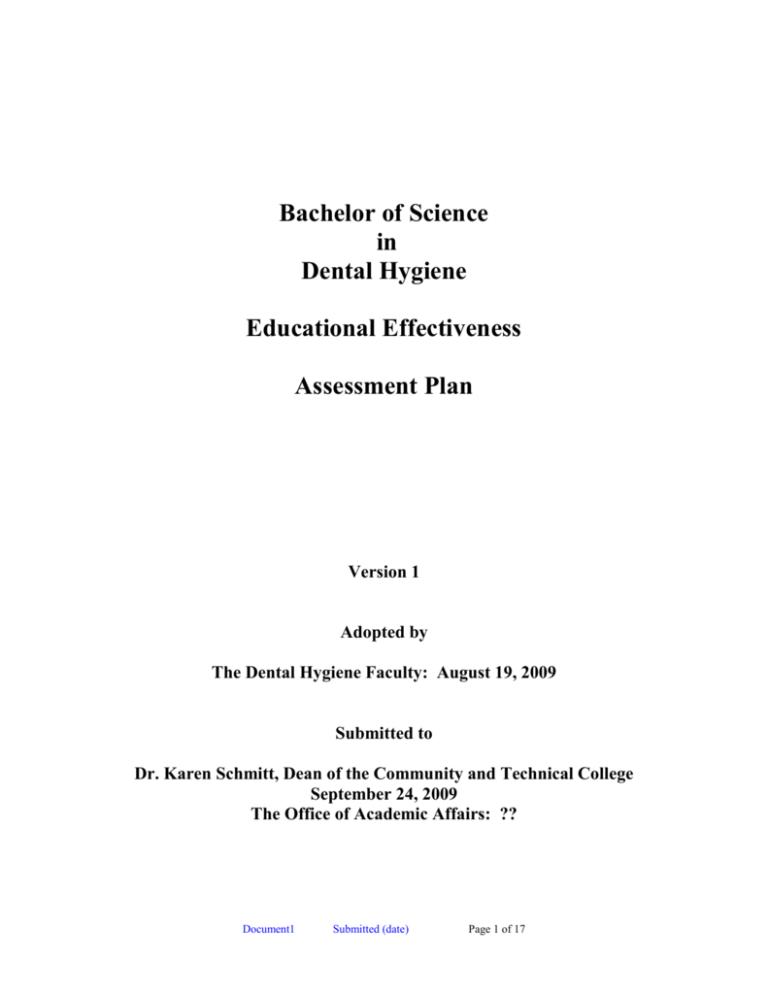
Bachelor of Science in Dental Hygiene Educational Effectiveness Assessment Plan Version 1 Adopted by The Dental Hygiene Faculty: August 19, 2009 Submitted to Dr. Karen Schmitt, Dean of the Community and Technical College September 24, 2009 The Office of Academic Affairs: ?? Document1 Submitted (date) Page 1 of 17 TABLE OF CONTENTS Mission Statement _________________________________________________________________________ 3 Program Introduction ______________________________________________________________________ 3 Assessment Process Introduction _____________________________________________________________ 3 Program Outcomes ________________________________________________________________________ 4 Table 1: Association of Assessment Measures to Program Outcomes ________________________________ 5 Assessment Measures ______________________________________________________________________ 6 Table 2: Program Outcomes Assessment Measures and Administration ______________________________ 6 Assessment Implementation & Analysis for Program Improvement _________________________________ 7 General Implementation Strategy ___________________________________________________________________________ 7 Method of Data Analysis and Formulation of Recommendations for Program Improvement ______________________________ 7 Modification of the Assessment Plan ________________________________________________________________________ 7 Appendix A: Literature Review ______________________________________________________________ 8 Measure Description:_____________________________________________________________________________________ 8 Factors that affect the collected data:_________________________________________________________________________ 8 How to interpret the data: _________________________________________________________________________________ 8 Appendix B: Community Projects ___________________________________________________________ 11 Factors that affect the collected data:________________________________________________________________________ 11 How to interpret the data: ________________________________________________________________________________ 11 Appendix C: Western Regional Examining Board Restorative Examination _________________________ 14 Measure Description:____________________________________________________________________________________ 14 Factors that affect the collected data:________________________________________________________________________ 14 How to interpret the data: ________________________________________________________________________________ 14 Appendix D: Competencies ________________________________________________________________ 15 Measure Description:____________________________________________________________________________________ 15 Factors that affect the collected data:________________________________________________________________________ 15 How to interpret the data: ________________________________________________________________________________ 15 Document1 Submitted (date) Page 2 of 17 MISSION STATEMENT The mission of the UAA Dental Hygiene Bachelor of Science Degree (BSDH) Program is to educate dental hygiene students in dentally-related areas beyond the associate degree level. PROGRAM INTRODUCTION Student completing the Dental Hygiene Program’s Associate of Applied Science degree earn substantially more credits than is required of most AAS degrees. The BSDH was established to articulate with University of Alaska Anchorage’s AAS in Dental Hygiene, allowing students to complete their requirements for a baccalaureate degree in approximately one year. Students focus on restorative dental hygiene and/or educational methodology in dental hygiene education. ASSESSMENT PROCESS INTRODUCTION This document defines the expected student learning outcomes for the Dental Hygiene Bachelor of Science Degree and outlines a plan for assessing the achievement of the stated outcomes. Development of the outcomes in this plan was part of the BSDH development and consisted of initial development by full time faculty, then review and approval of the outcomes and assessment process by the full faculty. Document1 Submitted (date) Page 3 of 17 PROGRAM OUTCOMES At the completion of this program, students are able to: 1. Critically evaluate research studies. 2. Assess, plan, implement, and evaluate complex community oral health projects to diverse populations. 3. Perform advanced dental hygiene skills beyond the associate degree level, e.g. restorative functions and/or clinical instruction. Document1 Submitted (date) Page 4 of 17 1. Critically evaluate research studies. 2. Assess, plan, implement, and evaluate complex community oral health projects to diverse populations. 3. Perform advanced dental hygiene skills beyond the associate degree level, e.g. restorative functions and/or clinical instruction. 1 0 0 0 0 1 0 0 0 0 1 1 0 = Measure is not used to measure the associated outcome. 1 = Measure is used to measure the associated outcome. Document1 Submitted (date) Competencies WREB Restorative Examination Outcomes Community Projects Literature Reviews TABLE 1: ASSOCIATION OF ASSESSMENT MEASURES TO PROGRAM OUTCOMES Page 5 of 17 ASSESSMENT MEASURES A description of the measures used in the assessment of the program outcomes and their implementation are summarized in Table 2 below. The measures and their relationships to the program outcomes are listed in Table 1, above. There is a separate appendix for each measure that shows the measure itself and describes its use and the factors that affect the results. TABLE 2: PROGRAM OUTCOMES ASSESSMENT MEASURES AND ADMINISTRATION Measure Literature review Community projects WREB Restorative Examination Competencies Frequency/ Start Date Description Written and class discussion on professional literature assignments Spring semester Student group projects involving community involvement Spring semester Clinical examination of restorative skills performed on a typodont and required for Alaska state certification. Skill-based assessments in laboratory and clinical courses Document1 Collection Method Written assignment Written and oral presentation Administered by Faculty Faculty Spring semester Clinical examination Western Regional Examining Board (WREB) As necessary Grading by observation Faculty Submitted (date) Page 6 of 17 ASSESSMENT IMPLEMENTATION & ANALYSIS FOR PROGRAM IMPROVEMENT General Implementation Strategy All but one assessment measure are incorporated into curriculum. Students taking the restorative coursework will take the Western Regional Examining Board (WREB) in order to become certified, and WREB provides student scores to the educational institution offering the courses. Method of Data Analysis and Formulation of Recommendations for Program Improvement Didactic and clinical faculty meet at the end of the academic year to review program outcomes. Discussion allows suggestions for program improvement and honest evaluation of both student performance and the assessment process. The information from this meeting is used by the Assessment Coordinator to generate an assessment report. The report is sent electronically to faculty for review and comment, then submitted to the Community and Technical College Dean’s office. The results of the data collection, an interpretation of the results, and the recommended programmatic changes will be forwarded to the Office of Academic Affairs (in the required format) by October 15th each year. Modification of the Assessment Plan The faculty, after reviewing the collected data and the processes used to collect it, may decide to alter the assessment plan. Changes may be made to any component of the plan, including the outcomes, assessment measures, or any other aspect of the plan. The modified assessment plan will be forwarded to the dean/director’s office and the Office of Academic Affairs. Document1 Submitted (date) Page 7 of 17 APPENDIX A: LITERATURE REVIEW Measure Description: Written and class discussion on professional literature assignments Factors that affect the collected data: Written literature evaluation is mostly objective, based on rubric, and therefore provides consistent results with little bias. How to interpret the data: A rubric for the written literature review is on the following page. The written report provides insight into student understanding of proper research methodology and student ability to critically analyze scientific literature. Document1 Submitted (date) Page 8 of 17 Criteria for Professional Literature Review Pts Criteria A B C D E Self Evaluation Overall description of the article 1 Title concise and descriptive 2 Author’s affiliations & credentials noted a Researcher has satisfactory reputation for well-conducted research b Researcher is not affiliated with a commercial firm 3 Article found in reputable, peer-reviewed journal a Journal has an editorial review board; articles are peerreviewed prior to publication b Journal is affiliated with a learned society, professional group, specialty group, or reputable scientific publisher c Journal is not a “popular” magazine sponsored by a cause or published by a commercial firm d Concisely written using a scientific style 4 Data published indicate current knowledge & are not outdated by more recent research Author has qualifications to write the article 1 Author’s current or past position supports expertise in a particular area 2 If reporting research results, there is evidence of finances & facilities to support the research References are available for articles 1 References are comprehensive, accurate, & reputable 2 Given the topic, there is an appropriate number of current references, although older references may be indicated for historical purposes or because Research problem is clearly, accurately, & completely described 1 Purposes of the study are clearly stated 2 There is a thorough review of the literature 3 Important terms &concepts are defined adequately 4 Hypotheses or objectives are adequate & clearly stated; hypothesis or objective follow directly from the problem statement Prospective & retrospective research require a different evaluation & materials & methods section 1 Characteristics of the population sampled are described; allocation of groups outlined if a clinical trial 2 Sampling techniques are described & adequate Document1 Submitted (date) Page 9 of 17 Instructor Evaluation Pts Criteria Self Evaluation 3 There is evidence of no bias in selection or assignment of objects or persons in the sample 4 Research design is described; there is control indicated for variables that might influence the results; comparability of experimental & control groups is evident’ limitations of the design are pointed out 5 Tests & instruments used give reasonable measures of the factors under study a Tests & instruments used are valid & reliable b Conditions in which measurements are made are described c Duration of study is appropriate 6 All factors needed to test the hypotheses or achieve the objectives are included in the analysis a Statistical tests are described; general-purpose computer programs for data analysis are specified b Hypotheses are tested through statistical analysis 7 Findings are presented in a clear manner a Data tables & figures are clear, easy to understand, & titled b Data are presented in a straightforward manner; authors report statistical method used & reason for selection 8 Discussion highlights significant issues from the research a Author may speculate on the significance of the findings b Strengths & limitations of the study are stated c Treatment or study complications & adverse effects are reported d Results are related to the current literature & implications for practice or the profession 9 Conclusions are supported by the methods used & the findings Total Points Document1 Submitted (date) Page 10 of 17 Instructor Evaluation APPENDIX B: COMMUNITY PROJECTS Measure Description: Student group projects involving diverse community populations. Factors that affect the collected data: This measure is based on assessing, planning, implementing, and evaluating community oral health projects. Projects will, by nature, be different, which can make grading more difficult. A grading rubric for each stage of the project development helps maintain grading consistency. How to interpret the data: It is ethically responsible for professionals to participate in community service activities. By requiring students to participate in community activities for diverse groups, the Dental Hygiene Program exposes students to diversity, the need for community service, and the personal satisfaction that can be obtained. An extensive grading rubric is used for evaluation of the community project; one section of it is included as a sample. Document1 Submitted (date) Page 11 of 17 CRITERIA SHEET XI FORMAT FOR FINAL REPORT P t s INTRODUCTION (14PTS) 1. Population is clearly identified 2 2. Population is described 2 3. Oral problem described 2 4. Statement of need or problems 2 5. Library research incorporated-at least 3 journal articles cited 6 ASSESSMENT (16PTS) 1. Description of facility and its role in the community is provided 2 2. Personnel responsible described 2 3. Dental health care mechanisms described 2 4. Attitudes, knowledge, values summarized 2 5. Issues re: dental health summarized 3 6. Community profile provided 5 PLANNING (25 PTS) 1. Problems clearly identified 5 2. Limitations of students doing implementations identified 2 3. Priorities listed 3 4. Goals listed 2 5. Objectives listed 3 6. Solutions listed 5 7. Presentation of plan to appropriate persons 8. Target population identified and method of sampling described 3 2 IMPLEMENTATION (15 PTS) 1. Activities done to meet each goal are explained Document1 Submitted (date) Self Evaluation I 15 Page 12 of 17 Instructor I Evaluation II EVALUATION (19 PTS) 1. Evaluation mechanisms included in appendix 2 2. Presentation of data is provided a) summary of findings b) tables and/or graphs appropriately labeled c) extraneous variables mentioned d) interpretation of results 5 3 2 4 3. Recommendations made 3 ADDITIONAL (11PTS) 1. Title Page 1 2. References: proper format employed 10 REPORT FORMAT (16 pts) 1. Agreement between use of singular and plural nouns and pronouns 2. Use of the simple present tense or simple past tense only 3. Use of the third person only 100 Total Points 16 16 2 2 2 5. Agreement between nouns, pronouns, and verbs 2 6. Correct grammar 2 7. Complete sentences (no fragments, comma slices, or run on sentences 8. Avoid the use of commas. When in doubt, do not use commas 2 Submitted (date) 100 2 4. No colons or semicolons Document1 Total Points 2 Page 13 of 17 APPENDIX C: WESTERN REGIONAL EXAMINING BOARD (WREB) RESTORATIVE EXAMINATION Measure Description: Clinical examination of restorative skills performed on a typodont and required for Alaska state certification. Factors that affect the collected data: Assessment on typodont (mouth model) provides grading consistency because no patient factors exist to skew results. Nervous students may not perform to their best ability. How to interpret the data: A passing grade indicates the student is competent in placing amalgam and composite restorations. A non-passing grade may indicate incompetence, or that external factors affected performance. Students may retake the examination on another test date. This is a sample of the results report: Document1 Submitted (date) Page 14 of 17 APPENDIX D: COMPETENCIES Measure Description: Skill-based assessments in laboratory and clinical courses Factors that affect the collected data: 1. Scoring is somewhat subjective. 2. Poor faculty calibration can result in grading variation. 3. Students get nervous and may not perform to their best ability. How to interpret the data: Each skill has a specifically designed task analysis that lists each step or criteria. Faculty observe each student on each task, and students must perform to a pre-determined skill level to pass. This data demonstrates student skill competency. A sample task analysis sheet is provided on the following page. Document1 Submitted (date) Page 15 of 17 Student Name: ___________________________________ Date: ___________________________ Evaluator: ___________________________________ Score: __________________________ (15 points required to pass.) Student Teaching Competency Task Scoring Basis Organize/ prepare for classes Well prepared with all materials and well thoughtout plan for class time Lacked 1-2 materials or plan was lacking details Lacked 3 or more materials and/or plan was poorly developed Well engaged with students and able to distinguish performance levels. At times was engaged with students and/or was able to distinguish performance levels. Unengaged with students and/or was unable to distinguish performance levels. Focused time and effort on individual students, spending equal amount of time with each student. Able to ascertain student weaknesses and provide appropriate instruction. At times focused on students; Spent unequal between students; Sometimes ascertained weaknesses and provided appropriate instruction. Usually not focused on students. Spent unequal time between students; Usually could not distinguish student weaknesses nor help instruct. Provided fair and consistent evaluations. At times provided fair and consistent evaluations. Rarely provided fair and consistent evaluations. Assess student performance in lab or clinical activities Cultivate student skills through oneon-one interaction Evaluated student competence Selfevaluation Document1 Submitted (date) 4-5 3 1-2 4-5 3 1-2 4-5 3 1-2 4-5 3 1-2 Page 16 of 17 Peerevaluation Faculty evaluation Student Name: _____________________________________ Date: ___________________________ Evaluator: _______________________________________ Scoring: 0-2=unacceptable; 3-5=acceptable Occlusal AREA SELF INSTRUCTOR Marginal Ridge Mesial (high—low—wide—narrow—shape) Distal (high—low—wide—narrow—shape) Fossa Mesial (position—excess—overcarved—shape—define) Central (position—excess—overcarved—shape—define) Distal (position—excess—overcarved—shape—define) Triangular Ridges Transverse –Mesial High—low—wide—narrow—location—shape—bulky Oblique or Distal transverse High—low—wide—narrow—location—shape—bulky Margins Proximal Spillway Mesial (location—high—low—defined) Distal (location—high—low—defined) Contact Mesial (broad—small—high—low—open) Distal (broad—small—high—low—open) Embrasure Mesio-buccal or lingual (excess—over) Disto-buccal or lingual (excess—over) Gingival—(mesial—distal) (excess—over) Cavosurface Mesial (flashing—sub) Central (flashing—sub) Distal (flashing—sub) Gingival Floor Mesial (excess—sub) Distal (excess-sub) AVERAGE (divide by 19) TOTAL Document1 Submitted (date) Page 17 of 17





